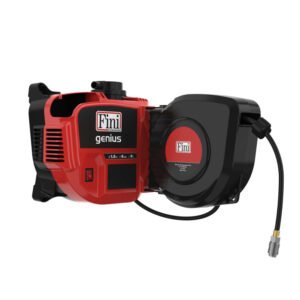Ever found yourself tangled in a web of wires and hoses in your workshop or home? Well, let’s talk about a game changer here; wall mounting. If you don’t want your air compressor filling up your floor space with wires, then a wall-mounted air compressor may be just what you need. Imagine having a powerful air compressor, minus the floor-clutter. That’s exactly what a wall-mounted air compressor is.
Now, you might be wondering, “Why wall mounted?” Here’s the deal – think of the space you’d save. No more dodging around a bulky floor unit, or spending precious time untangling hoses. Simply mount it on the wall and voila! – an organized and clutter-free workspace is yours.
Understanding Wall Mounted Air Compressors
Knowing how an air compressor works, in general, can help us appreciate the seamless operation of wall-mounted versions. Essentially, an air compressor functions as a storage system for pressurized air. It operates in a cycle that includes three key stages: intake, compression, and discharge.
During the intake stage, the compressor draws in ambient air through an inlet valve. In the compression stage, this air is compressed into a smaller volume under high pressure. Finally, in the discharge stage, the pressurized air is released for use through an outlet valve when required.
Now, the beauty of a wall-mounted air compressor is that this operation remains unaffected even after mounting. The compressor can still take in air, compress it, and release it just as efficiently as a floor model. The only difference is where the air compressor resides.
Benefits of Wall Mounting Air Compressors
Wall-mounted air compressors, just like any other pneumatic tools, come with several advantages as outlined below.

Space Saving Design
One major advantage that sets wall-mounted air compressors apart from their counterparts is the space-saving design. In many workshops, space is premium. Having a compressor that can be installed on the wall frees up valuable floor space, which can then be used for other important tools and equipment. So, if you’re struggling with a cramped workspace, a wall-mounted compressor might be right for you.
Ease of Use
Another point that really sells wall-mounted compressors is their ease of use. They are typically equipped with easy-to-read gauges, allowing you to monitor the pressure levels at a glance. Many models also feature automatic on/off switches, eliminating the need for manual operation. This means you can focus more on my work and less on checking the compressor.
Durability
Wall-mounted air compressors are designed with durability in mind. They are usually made from high-quality materials that can withstand the wear and tear of regular use. Also, since they are mounted on the wall, there is less risk of accidental damage from drops or spills. This gives you peace of mind knowing your compressor will last for years to come.
Convenient Maintenance
Maintenance is a crucial aspect of any tool or equipment, and wall-mounted air compressors make it easier to keep up with regular maintenance. Since they are mounted on the wall, you can easily access all the components for cleaning and servicing.
Drawbacks of Wall-Mounted Air Compressors
Despite the numerous advantages, wall-mounted air compressors do have some drawbacks that are worth considering.
Installation
The installation process can be quite daunting. Unlike portable compressors, these units need to be mounted on the wall or ceiling, which requires a bit more technical know-how. You may have to hire a professional, which adds to the overall cost, which is something you have to deal with.
Noise Production
While the noise level is generally lower than portable units, wall-mounted air compressors still generate some noise. If your workspace is in a residential area or if noise is a particular concern for you, you might find the sound level still disruptive.
Portability
Wall-mounted air compressors are not as portable as their counterparts. Once installed, they remain fixed in one location, limiting your flexibility to move around with your compressor. This can be a significant limitation when you have jobs around the house or yard that could have been made easier with a portable compressor.
Applications of Wall-Mounted Air Compressors

Automotive Workshops
Wall-mounted air compressors are perfect for automotive workshops. They can power tools such as pneumatic wrenches and impact drivers, making it easier to tackle stubborn bolts and nuts on vehicles.
Painting
If you are a professional painter or enjoy painting as a hobby, wall-mounted air compressors can make your job much more manageable. These units can run paint sprayers and sanders, allowing you to cover larger areas quickly and achieve a smoother finish.
Woodworking
Wall-mounted air compressors are ideal for powering woodworking tools such as nail guns, staplers, and sanders. They provide consistent pressure, ensuring precision and efficiency in your projects.
Home DIY Projects
For any home DIY enthusiast, wall-mounted air compressors are a game-changer. They can power tools for tasks such as inflating tires, blowing debris, and even cleaning gutters. With a wall-mounted air compressor, you no longer have to rely on manual labor for these tedious tasks.
Manufacturing Industry
These compressors play a pivotal role in manufacturing industries. These compressors are firmly mounted on walls to power assembly line machines. They provide the much-needed airflow to speed up production processes, making them an essential cog in manufacturing operations.
Medical and Dental Facilities
Wall-mounted compressors are widely used in medical facilities where they supply clean, dry air for procedures, ensuring a sterile environment. They’re crucial for patient safety and care, proving that wall-mounted air compressors indeed have far-reaching and diverse applications.
What are the four types of air compressors?
The four main types of air compressors, which vary based on their operating principle and applications, are:
Reciprocating Air Compressors – These compressors work through a piston within a cylinder, compressing the air by moving back and forth. They are commonly used in small-scale operations, such as workshops and garages.
Rotary Screw Compressors – Utilizing two rotors within a casing, these compressors trap air between the screws and the casing, compressing the air as it moves through. They are suited for continuous, high demand applications.
Centrifugal Compressors – These are dynamic compressors where compression is achieved through the acceleration of air by a rapidly rotating impeller. They are used in high-capacity applications, such as turbine engines in aircraft.
Axial Compressors – Axial compressors are a type of dynamic compressor that efficiently compresses air by forcing it through a series of rotor blades and stators arranged in a series. They are most often used in high-speed engines, like those found in jet aircraft.
Which type of air compressor is best?
The best type of air compressor depends largely on the specific needs of the application it’s being used for. Reciprocating Air Compressors are ideal for small businesses, home workshops, and DIY enthusiasts due to their lower initial cost and simplicity in maintenance. They’re perfect for tasks that require intermittent use with varying pressure demands. Rotary Screw Compressors, on the other hand, are more suited for continuous industrial applications due to their efficiency and ability to provide a steady airflow. They operate best in large-scale operations where the air demand is constant.
What is the most efficient type of air compressor?
The most efficient type of air compressor is generally considered to be the Rotary Screw Compressor for several reasons. Firstly, it can operate 24/7 without overheating, thanks to its design, which minimizes friction and dissipates heat effectively. This type is also known for delivering a consistent output of compressed air, making it ideal for applications requiring a steady, reliable air supply.
Rotary Screw Compressors are more energy-efficient than their counterparts, especially in settings where a continuous flow of air is a necessity. Their efficiency is further enhanced by variable speed drives, which allow the compressor to adjust its motor speed to the demand, reducing power consumption. While the initial cost may be higher, the long-term energy savings can be significant, making them a cost-effective choice for sustained, high-volume use.
What is the most reliable compressor type?
When it comes to reliability, the Rotary Screw Compressor once again stands out among air compressors. Its design and operational features contribute significantly to its dependability. Unlike reciprocating air compressors, which can suffer from wear and tear due to their many moving parts, rotary screw compressors have fewer components that come into direct contact with each other. This reduced friction not only improves energy efficiency but also decreases the rate of wear, extending the lifespan of the compressor.
What type of air compressor lasts the longest?
Among various air compressor types, the Rotary Screw Compressor not only excels in efficiency and reliability but also in longevity. Its design inherently offers a longer operational life, primarily because it operates with less vibration compared to other types of compressors. This attribute is crucial, as less vibration means less mechanical stress on the compressor’s components, leading to a reduced likelihood of premature failures.
The oil-injected rotary screw compressor, which uses oil to cool and lubricate the internal parts, further enhances durability by minimizing wear and tear. With proper maintenance, such as regular oil changes and filter replacements, these compressors can continue to operate efficiently for many years, often outlasting alternative compressor models.
Where is the best place to mount an air compressor?
The optimal mounting location for an air compressor greatly depends on its type and the specific needs of the application. However, there are several universal factors to consider to ensure efficient and safe operation. Ideally, an air compressor should be mounted in a well-ventilated area to prevent overheating and ensure adequate air intake. It should also be placed on a stable, level surface to minimize vibration and potential damage.
Accessibility for maintenance, noise reduction, and protection from environmental elements like direct sunlight, rain, or excessive dust are additional considerations. For larger industrial settings, placing the compressor in a dedicated room with soundproofing can help manage noise levels, while in smaller workshops, mounting it close to the point of use can reduce the need for extensive piping and thus preserve air pressure and quality.
Conclusion
There is just a lot to the utility and convenience that wall-mounted air compressors bring to any workspace. They’re space-efficient, easy to access, and incredibly durable. The compact nature of these machines, coupled with their high functionality, makes them a worthwhile investment for both professional and personal use.
One key takeaway from my experience is this: don’t underestimate the impact of a wall-mounted air compressor on your workspace. They’re a smart investment for anyone serious about their craft, be it a professional or passionate hobbyist. With their minimal space requirement and optimal performance, these devices are a prime example of how modern technology can simplify our lives.

